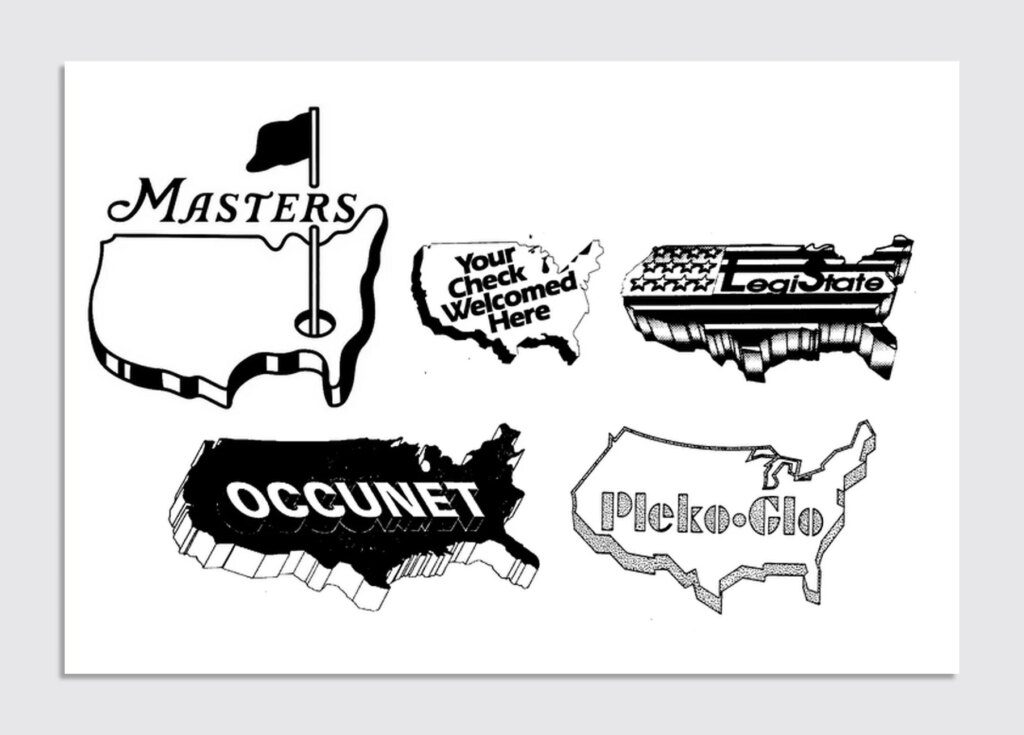A nation is reflected in its logos. This is why, according to World Intellectual Property Organization data, 27% of all logos with tulips are registered in the Netherlands and New Zealand’s trademarks contain kiwis at a rate 78 times higher than the rest of the world. So in a time of pronounced national disunity, what are we to make of the fact that the use of logos featuring the outline of the continental United States is at its lowest level ever?
As a recognizable, roughly rectangular shape that could be employed as a sort of frame around a company name, the silhouette of the lower 48 states gained popularity as a graphic device in the 1960s, ironically just after the 1959 admission to the Union of the two states it excluded, Alaska and Hawaii. The U.S. map appeared in roughly one out of 200 new logos that decade, United States Patent and Trademark Office records tell us, and provided a simple way for an American business to boast, in the words of ZZ Top, “I’m bad, I’m nationwide.”
Designers had a field day with the shape, incorporating it in a variety of motifs, often accompanied by brand names that reinforced the notion of countrywide reach: National Trailways Bus System, American Farm Bureau Federation, United Van Lines. One popular use, exemplified most famously in the logo of the Masters golf tournament, depicted the U.S. as a three-dimensional slab of land with precipitous edges, as if crossing the Mexican border would send you plummeting over a massive cliff.

Other logos utilized the U.S. shape in more creative ways, from mounting it on a trailer to stacking it with boxes. Some boiled the shape down to its essence, expressing it as an abstraction, while others seemed to struggle with geographical reality, occasionally erasing Michigan and adding parts of Canada, or putting forward a blobby vision of the United States that was virtually unrecognizable. In general, designers seemed to prefer to present the nation using the Albers map projection, which has Maine jutting up to the north, calling to mind Lady Liberty’s torch proudly held aloft, rather than the Mercator projection, which forces New England to splay awkwardly out into the Atlantic.

But we just don’t see as many U.S.-shaped logos in the 2020s. Since the 1960s, their rate of use has dropped 88%. Similarly, the terms “American,” “National,” “United,” and “USA” now appear less often in U.S. trademarks. Is this a reflection of declining national unity?
!function(){“use strict”;window.addEventListener(“message”,(function(a){if(void 0!==a.data[“datawrapper-height”]){var e=document.querySelectorAll(“iframe”);for(var t in a.data[“datawrapper-height”])for(var r=0;r<e.length;r++)if(e[r].contentWindow===a.source){var i=a.data["datawrapper-height"][t]+"px";e[r].style.height=i}}}))}();
Perhaps globalization played some part. It’s worth noting that globes in logos and “Global” in trademarks peaked in the 1990s and 2000s, respectively, before similarly declining. It simply may be that using a name or logo to announce that your business is national, or global, is not the flex it once was. No one is really impressed by such scale at this point; it’s expected.
!function(){“use strict”;window.addEventListener(“message”,(function(a){if(void 0!==a.data[“datawrapper-height”]){var e=document.querySelectorAll(“iframe”);for(var t in a.data[“datawrapper-height”])for(var r=0;r<e.length;r++)if(e[r].contentWindow===a.source){var i=a.data["datawrapper-height"][t]+"px";e[r].style.height=i}}}))}();
Ironically, these days there’s perhaps more branding hay to be made at a local level. The use of area codes and state outlines in branding is on the rise, leaving national symbols like the U.S.-shaped logo in the dust. In an age where products that are small-batch, locally sourced, and artisanal give products a cachet missing from those that are mass-produced and widely distributed, emphasizing your company’s connection to a particular region can serve as an important point of differentiation. Americans, after all, are known for hating Congress but loving their own congressional representative. It seems there’s nothing more American than local pride.


